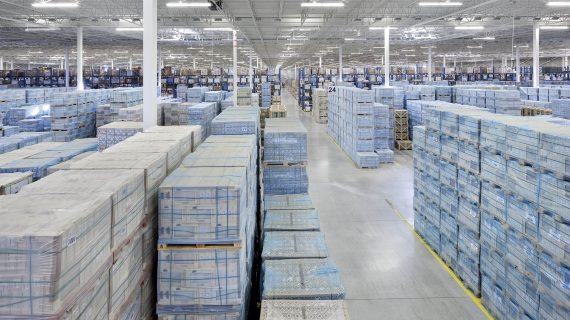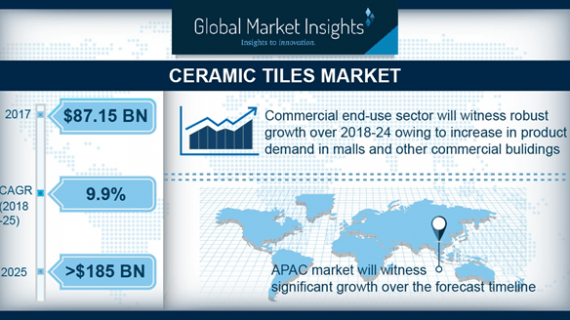GLOBAL CERAMIC TILES MARKET FORECAST 2020-2028
In terms of revenue, Research estimates that the market for ceramic tiles will grow with an estimated CAGR of 8.05% during the forecast period & will reach revenue of $230.41 billion by 2028. The base year considered for the market study is 2019 & the forecasted period is between 2020 and 2028.
The global ceramic tiles market growth is boosted by the following factors:
- Infrastructure development and favorable government policies
- Growing residential construction & flooring market
- Availability of abundant raw materials
The increasing construction activities are one of the major factors that fuel the growth of the ceramic flooring market in developing regions like the Middle East and the Asia Pacific. Moreover, the mega-urban development projects in these regions have positively impacted the growth of the market. In addition, the increasing educational buildings, hospitality buildings, leisure, and recreational facilities have led to the development of the flooring industry. Moreover, the rising disposable income and the ability to spend more on premium quality items with aesthetic finish boost the demand for ceramic floor tiles worldwide. Furthermore, the surging urbanization and construction of low-rise buildings, mid-rise buildings, and high-rise buildings supplement the market growth.

Residential Replacement is the dominating segment in terms of revenue in the global ceramic tiles market, with around 34.08% in 2019. There have been increasing renovation activities due to the aging of old buildings and commercial spaces, the growing demand for durable materials, coupled with the emergence of ceramic floor tiles as the hardwood replacement and other flooring replacement options. Major applications in residential replacement are flooring and walls. Most of the residential buildings choose to employ floor tiles in apartments for the replacement due to ease of application, low cost, and the availability of a large variety of sizes and shapes. Similarly, for walls tiles, in spite of them being external or internal. They can be used quickly to change the color of a room or to make patterns on the internal wall. Moreover, in terms of revenue, the new residential segment is anticipated to grow at the highest CAGR of around 9.01% during the forecast period. The fastest growth rate of the new residential segment is attributed to the rising demand for single-family housing projects, and the growing spending capacity of consumers in the region. Companies have increased their focus on quality flooring, which has features such as dust resistance, protection, and adds aesthetic value. The growing demand for energy-efficient green buildings that can provide temperature insulation is expected to propel the market demand in the region.
On the other hand, the market growth is restricted by fluctuating raw material prices, co2 emissions from ceramic tiles, rising demand for substitute products like glass and rubber tiles. Volatile raw material prices are a major challenge for the ceramic tiles market, since it ultimately increases the cost of production and reduces the profit margin for the tiles companies. Also, they can lose the market share because of the high cost of raw material, and hence the companies must form strategies to maintain a stronghold on the market. Basic raw materials are clays, silica, sand, grog, or feldspar. The prices of the raw material have increased, as the use of raw material has extended to other applications. The cost of feldspar was about $190 per ton, but since its applications increased, its price also increased partially. In 2016, the bentonite clay price was approximately $74 per ton as compared to the year 2015 price of $65 per ton. The prices of the basic raw material of ceramic tiles are constantly fluctuating. Therefore, it is a major challenge that companies need to handle.
The report scope of the global ceramic tiles market covers segmentation analysis of raw materials, product type, and end-use.
Market by Raw Materials:
- Silica Sand
- Kaolin
- Bentonite
- Feldspar
- Other raw material
Market by Product Type:
- Industrial Tile
- Floor Tile
- Vitrified Tile
- Wall Tile
Market by End-Use:
- Commercial
- New Residential
- Residential Replacement
- Other End Use
Geographically, the global ceramic tiles market has been segmented on the basis of four major regions, which includes:
- North America: the United States and Canada
- Europe: the United Kingdom, Germany, France, Italy, Russia, Belgium, Poland, and Rest of Europe
- Asia Pacific: China, Japan, India, South Korea, Indonesia, Thailand, Vietnam, Australia & New Zealand, and Rest of Asia Pacific
- Rest of World: Latin America, the Middle East & Africa
Geographically, Asia Pacific is the largest & fastest market with a market share of 68.32% in terms of revenue in 2019. The dominance of the Asia Pacific market region is attributed to the increasing constructional activities in countries present in the region. Due to this, the key ceramic companies are shifting their production centers in the Asia Pacific region. The growing economic prominence of India, China, and Southeast Asia, as a result of the presence of cheap labor, a high level of resources, and a large consumer base, is driving the construction industry in the region, which further propels the market growth for ceramic tiles in the region. The growing urbanization in the region, especially in China and the Philippines, is expected to propel population growth in the cities. This trend will increase the congestion in the city, which, in turn, will increase the demand for utilities, leading to increased housing demand in the region. The trend is expected to continue over the forecast period and is expected to segment the market growth of the region.





